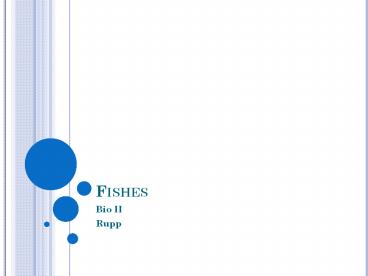Fishes - PowerPoint PPT Presentation
1 / 45
Title:
Fishes
Description:
FISHES Bio II Rupp GANOID SCALES CTENIOD SCALES CYCLOID SCALES PLACOID SCALES Typical in sharks FISH MUSCULATURE Myomeres-segments of the muscle Myospeta division ... – PowerPoint PPT presentation
Number of Views:183
Avg rating:3.0/5.0
Title: Fishes
1
Fishes
- Bio II
- Rupp
2
Types of Fishes
- Jawless
- Cartilaginous
- Bony
3
(No Transcript)
4
Fish Characteristics
- 4 hallmarks of chordates
- Sharks
- Lateral line
- Ampullae of Lorenzini
- Operculum
- Gills
- Tail types
- Scale types
- Fish musculature
- Swimming and the swim bladder
5
Taxonomy
- Kingdom Animalia
- Phylum Chordata
- Subphylum Vertebrata
6
Class Myxini
- Hagfish
7
Class Cephalospidomorphi
- Lampreys
8
Class Chondrichthyes
- Sharks, skates, and rays
9
Class Actinopterygii
- Ray-finned fishes
10
Class Sarcopterygii
- Lobe-finned fishes
11
Chordate Hallmarks
- Notochord
- Hagfishes and lampreys keep this their entire
lives - Made of thick-walled and fluid-filled cells
pressed closely together
12
Chordate Hallmarks
- Dorsal hollow nerve cord
- Neural tube formation
- Anterior becomes the brain
13
Chordate Hallmarks
- Pharyngeal gill slits/pouches
14
Chordate Hallmarks
15
Fish Definition
- For our purposes
- A gill-breathing, poikilothermic (cold-blooded),
aquatic vertebrate that possesses fins and a skin
that is usually covered in scales - Approximately 25,000 species
- Two basic body forms
- Agnathansjawless
- Gnathostomesjawed
16
Agnathans
- Cephalospidomorphilampreysectoparasites
- Myxinihagfishesscavengers
17
(No Transcript)
18
(No Transcript)
19
(No Transcript)
20
(No Transcript)
21
Superclass Gnathostomes
- Cartilaginous fishes
- Class Chondrichthyesapprox. 850 species
- Subclass Elasmobranchiisharks, skates, and rays
- Dogfish anatomy
22
Dogfish Anatomy
23
Dogfish Anatomy
24
Dogfish Anatomy
25
Gnathostome Adaptations
26
Gnathostome Adaptations
27
Gnathostome Reproductive Strategies
- Internal fertilization
- Oviparoussome species lay eggs immediately after
fertilization
- Ovoviviparousretain the developing young in the
uterus and they are nourished by yolk sacs - Viviparousyoung are nourished by a placenta
28
Superclass Gnathostomes
- Bony fishes, aka osteichthyes
- Class Actinopterygiiray-finned fishes
- Class Sarcopterygiilobe-finned fishes
29
Osteichthyes Adaptations
- Operculum
- Tail types
- Skin and scales
- Musculature
- Swimming
- Swim bladder
- Gills
30
Operculum
- A bony plate attached to a series of muscles
running over the gills - Aid in more efficient respiration
- Bernoullis Principle of Fluid Dynamics
31
(No Transcript)
32
Tail Types
33
Scale Types
- Scales are embedded in the dermis and covered by
the epidermis - Types
- Ganoid
- Cycloid
- Ctenoid
- Placoid
34
Ganoid scales
35
Cteniod scales
36
Cycloid scales
37
Placoid scales
- Typical in sharks
38
Fish Musculature
- Myomeres-segments of the muscle
- Myospetadivision point of the myomeres
- Vertical septum and horizontal septum of body
cavity
39
(No Transcript)
40
Fish Musculature
- Red muscle or dark muscle is used in regular
swimming - Red muscle is dark due to extra myoglobin and
extreme vascularization - Red muscle is often referred to as the bloodline
- White muscle for escape response
41
Swimming
- Short muscular bodies and lunate tails for most
efficient swimming
42
Swim bladders
- Maintain neutral buoyancy and depth control
- Balloon-like structure
- Pulls gas out of the water to inflate
- Two types
- Attached to gutancient fishes
- Detached from gutmore modern fishes
- Fish without swim bladders tuna, flounder,
sharks, deep ocean fish - Sharks have a huge fatty liver to maintain
neutral buoyancy
43
(No Transcript)
44
Gills
- Made of filaments called lamellae
- Rich with blood vessels
- Covered by operculum or gill slits
- Counter current blood flow of blood and water
increases efficiencydemonstration
- Gill arches are the point of attachment for
lamellae - Gill rakers remove debris from gills
- Larger gill surface is often correlated with
higher fish activity levels
45
(No Transcript)































